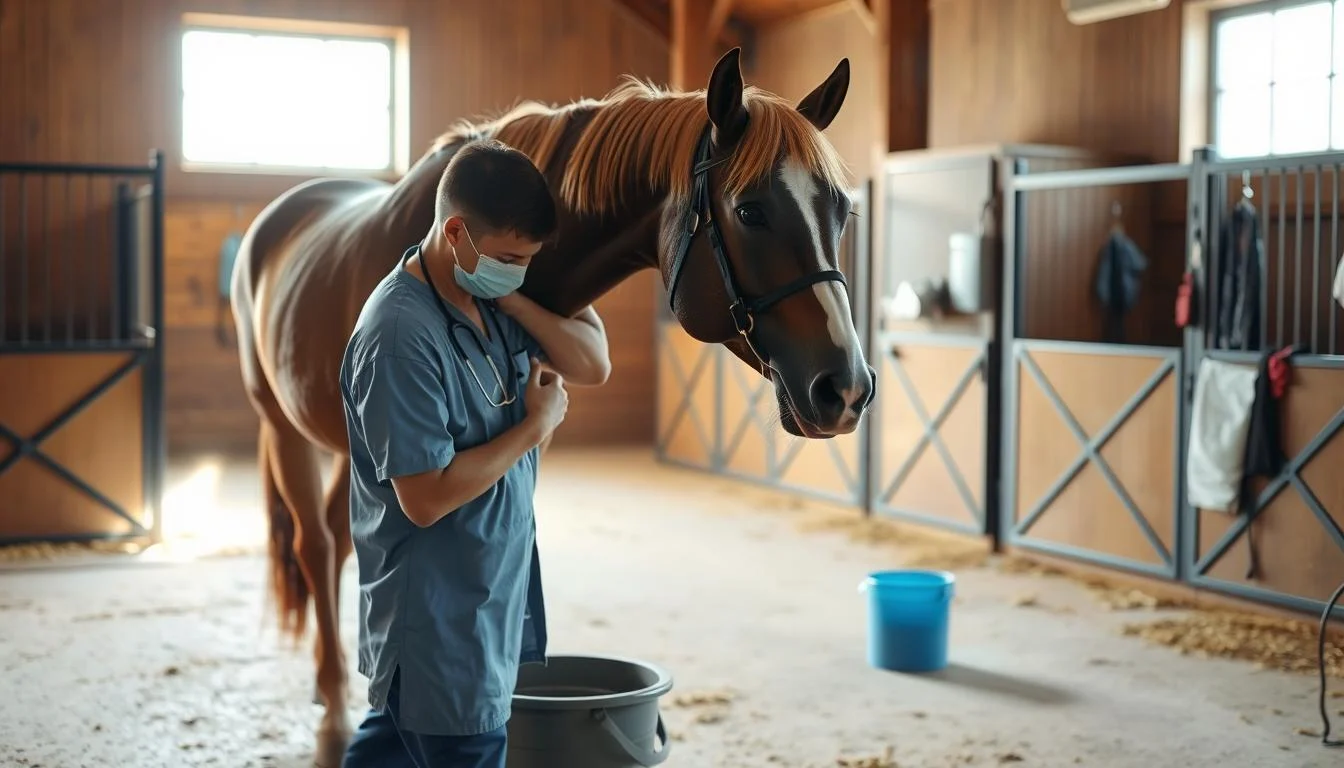Did you know 70% of first-time equine owners underestimate the costs and logistics of proper care? For those new to ownership, finding a safe, structured environment for their animals is often the biggest challenge. This is where professional boarding services step in—offering tailored solutions for owners who lack space or expertise.
Boarding facilities provide more than just shelter. They deliver specialized care, from nutrition plans to veterinary coordination, ensuring your companion thrives. Socialization with other animals is another key benefit, reducing stress and promoting natural behavior.
Choosing the right facility requires understanding contracts, services, and daily routines. This guide simplifies the process, helping you identify red flags and prioritize essentials like safety protocols or turnout schedules. With clear expectations, you’ll confidently navigate this partnership.
Key Takeaways
- Boarding offers managed care for equines, ideal for owners without private land.
- Quality facilities provide socialization, professional oversight, and customized feeding plans.
- First-time owners often overlook hidden costs like emergency vet fees or seasonal rate changes.
- Contracts should clarify responsibilities, including medical decisions and visitation hours.
- Look for amenities like indoor arenas, secure fencing, and 24/7 staff availability.
Understanding Horse Boarding: The Basics
Ever wondered how full-time professionals manage their animals’ needs? Equine boarding offers a structured solution, allowing owners to entrust daily care to specialized facilities. These properties provide secure stabling, turnout areas, and round-the-clock supervision—ideal for those without private land or expertise.
What Does This Service Include?
Unlike basic pasture rentals, boarding involves comprehensive support. Trained staff handle feeding schedules, grooming, and health monitoring. Many locations also coordinate vet visits and farrier appointments, saving owners hours of logistical planning.
Advantages for Busy Caretakers
Key benefits include:
- Expert oversight: Professionals spot health issues early, preventing minor concerns from becoming emergencies.
- Social opportunities: Animals interact in group pastures, reducing anxiety and encouraging natural behaviors.
- Time savings: No more daily mucking stalls or sourcing hay—facilities handle routine tasks.
Modern properties often feature climate-controlled barns, riding arenas, and secure fencing. These amenities ensure physical comfort while promoting mental stimulation through varied environments.
Finding the Right Boarding Facility
How do you balance convenience with quality care when selecting a new home for your companion? Prioritizing key factors like location, infrastructure, and staff expertise ensures a stress-free experience for both you and your animal.
Location and Accessibility
A well-placed barn minimizes travel time for visits and emergencies. Look for properties near major roads but away from heavy traffic. Check if winter weather impacts access—gravel driveways or hilly terrain could become hazardous in snow or ice.
Proximity to veterinary clinics matters. Facilities within 30 minutes of 24/7 care offer peace of mind. Ample parking for trailers and daytime visitors is another practical detail often overlooked.
Facility Amenities and Safety Measures
Inspect the property’s layout. Stalls should allow easy movement, with proper ventilation and natural light. Outdoor arenas need secure footing, while group pastures require sturdy fencing—no loose wires or broken posts.
Ask about emergency protocols. Reputable management teams conduct fire drills and keep first-aid kits stocked. Automated water systems and shaded turnout areas prevent dehydration during heatwaves.
Reviews reveal hidden truths. Chat with current clients about staff responsiveness and problem-solving habits. A well-maintained boarding facility reflects pride in operations—peeling paint or cluttered aisles hint at deeper issues.
horse boarding guide
Understanding agreements between owners and boarding facilities ensures clarity on daily operations. Contracts outline responsibilities, costs, and care standards—critical details that prevent misunderstandings down the trail.

Types of Boarding Agreements
Most locations offer three primary service tiers:
| Agreement Type | Services Covered | Average Monthly Fee |
|---|---|---|
| Full Board | Feeding, stall cleaning, turnout | $600-$1,200 |
| Partial Board | Shared feeding/cleaning duties | $350-$550 |
| Self-Care | Owner handles all daily tasks | $150-$300 |
Key Contract Terms and Conditions
Review these elements before signing:
- Fee structures: Seasonal rate changes or extra charges for supplements
- Veterinary authorization protocols during emergencies
- Cancellation policies (30-day notice is standard)
Transparent contracts protect both parties. They specify who pays for unexpected medical treatments or damaged equipment. Always verify who oversees hoof care and deworming schedules—these details impact your companion’s wellbeing.
Ask questions if clauses seem vague. Reputable facilities welcome discussions about care standards and visitation hours. Clear paperwork fosters trust, letting you focus on your animal’s health rather than logistics.
Preparing Your Horse for Boarding
Proper preparation ensures your animal settles into their new routine without stress. Start by scheduling a veterinary visit at least two weeks before the move. This allows time for any necessary follow-ups if health issues arise.
Health and Vaccination Checks
Facilities require up-to-date vaccination records to protect all residents. Core vaccines like tetanus and rabies are non-negotiable. Deworming and dental exams prevent parasitic issues and chewing difficulties. Don’t forget hoof care—trimming or shoeing avoids lameness during initial turnout periods.
Discuss dietary needs with staff beforehand. Some locations adjust feeding schedules based on herd dynamics. Pack a 10-day supply of your usual hay to ease digestive transitions.
Packing Essentials for a Safe Stay
Create a labeled kit with these items:
- Grooming tools (brushes, hoof picks)
- Medications or supplements in original containers
- Weather-appropriate blankets
Mark all equipment with waterproof tags. Include care instructions for unique items like therapeutic pads. Facilities appreciate when owners provide contact details for their farrier and vet.
Hydration matters—bring a water bucket from home. Familiar scents encourage drinking in new stalls. Double-check facility rules about treats or toys to avoid conflicts.
Smooth Transportation and Arrival Process
Moving your equine companion to a new facility doesn’t have to feel overwhelming. With thoughtful planning and clear communication, you can ensure a stress-free transition that keeps your animal calm and secure.
Travel Tips and Trailer Preparation
Start by inspecting your trailer at least one day before departure. Check tire pressure, brake lights, and flooring for stability. Add ample bedding to absorb motion and provide traction—straw or shavings work best.
Schedule stops every 3-4 hours during long trips. Offer water and allow brief grazing in safe areas. Avoid feeding large meals right before travel to prevent digestive discomfort.
Arrival Procedures and Settling In
Upon arrival, staff should guide you through check-in paperwork and facility tours. Unload your companion in designated zones to minimize chaos. Introduce them slowly to herd mates—many locations use gradual turnout to build trust.
Bring familiar items from home, like a favorite brush or feed bucket. These small comforts ease anxiety while adapting to new routines. Facilities with round-the-clock staff excel at monitoring newcomers during those critical first days.
Consistency matters. Stick to your usual feeding time initially, then adjust gradually to the facility’s schedule. This balance helps animals feel secure while embracing their new environment.
Creating a Comfortable Environment
What separates adequate shelter from true comfort for animals in professional care? Top-tier facilities focus on thoughtful design that addresses physical needs and psychological well-being.
Stall and Pasture Setup
Well-designed stalls allow free movement while preventing injuries. Spacious layouts (12×12 ft minimum) with rubber-matted floors reduce joint stress. Pastures use rotational grazing systems to maintain fresh grass and prevent overgrazing in specific areas.
Secure dividers between enclosures minimize territorial disputes. Facilities often position shelters in shaded zones to protect from harsh sun or wind.
Water Management and Waste Disposal
Automatic waterers with temperature controls ensure constant access to clean hydration. Staff check troughs twice daily for debris. Waste removal happens on strict schedules—manure piles sit far from feeding zones to deter pests.
Some locations compost organic matter for eco-friendly disposal. This approach keeps pastures clean and reduces disease risks.
Climate Control and Bedding
Barns use adjustable ventilation systems for airflow without drafts. In winter, infrared heaters warm common areas, while summer misters cool turnout spaces. Dust-free bedding materials like flax shavings support respiratory health.
Safety remains central. Rounded stall edges and breakaway latches prevent accidents. These factors, combined with consistent routines, create calm environments where animals thrive.
Daily Care, Feeding, and Exercise Regimen
What’s the secret to keeping your equine companion thriving in a new environment? Consistent routines built around their biological rhythms. Structured schedules reduce stress while meeting core physical needs.
Establishing Feeding Schedules and Diet Requirements
Quality facilities tailor meals to individual requirements. Senior animals often need soaked hay, while active ones require high-energy grains. Key factors include portion control, feeding frequency, and hay quality.
| Schedule Type | Components | Frequency |
|---|---|---|
| Standard | Timothy hay, fortified pellets | 3x daily |
| Performance | Alfalfa mix, electrolyte supplements | 4-5x daily |
| Senior | Softened forage, joint support | Small portions 6x daily |
Grooming, Turnout, and Exercise Benefits
Daily turnout prevents stiffness and supports digestive health. Facilities often rotate pastures to maintain fresh grazing areas. Morning sessions allow energy release before heat peaks.
Grooming services include mane detangling and hoof cleaning. These rituals strengthen bonds between caretakers and animals. Regular exercise reduces boredom-related behaviors like stall pacing.
Pro tip: Share your companion’s favorite scratch spots with staff. Small details help them personalize care. Always provide written instructions for medical supplements or allergy alerts.
Balanced routines address essential needs through structured services. They create predictable environments where animals flourish physically and mentally.
Fostering Socialization and Interaction
A thriving equine companion needs more than physical care—emotional wellness through social bonds shapes their quality of life. Top facilities design programs where animals build trust through structured interactions while owners gain access to skill-building resources.
Turnout Options and Group Pasture Time
Daily herd time reduces stress and mimics natural herd dynamics. Facilities often provide:
- Supervised sessions: Staff monitor play to prevent conflicts
- Mixed-group pastures for balanced social hierarchies
- Individual turnout for shy or recovering animals
| Turnout Style | Group Size | Frequency |
|---|---|---|
| Supervised | 3-5 animals | 4-6 hours daily |
| Free-Range | 6-10 animals | Overnight access |
| Scheduled | 1-2 companions | Custom intervals |
Training and Riding Opportunities
Regular training sessions help animals stay engaged. Many barns offer:
- Groundwork lessons to improve handler communication
- Trail riding groups that explore nearby paths
- Indoor arenas for year-round skill development
Owners also want opportunities to bond during visits. Weekly clinics on grooming techniques or obstacle courses create shared learning moments. These activities let your companion receive consistent mental stimulation while strengthening your partnership.
Barns with vibrant communities often host social events. Potluck dinners or holiday parades turn routine care into memorable experiences. This atmosphere helps both animals and caretakers feel part of a supportive network.
Monitoring Your Horse’s Health and Wellbeing
Regular check-ins are your first line of defense in maintaining your companion’s vitality. Even with professional oversight, attentive owners notice subtle shifts that could indicate emerging issues. Daily observations paired with facility updates create a safety net for early intervention.

Recognizing Signs of Illness
Watch for these red flags:
- Reduced interest in feed or water
- Unusual lethargy during turnout or riding sessions
- Persistent cough, nasal discharge, or labored breathing
Track manure consistency and urination patterns—changes often precede visible symptoms. A dull coat or sudden weight loss also warrants immediate attention. Share these observations with staff to coordinate care.
Emergency Procedures and Veterinary Care
Establish clear communication channels with your facility’s team. Confirm who to contact after hours and their preferred method (text, call, etc.). Keep your vet’s number saved in multiple locations.
In critical situations:
- Isolate the animal if safe to do so
- Alert on-site staff and your veterinarian simultaneously
- Follow facility protocols for transport or treatment access
Many boarding contracts outline emergency response plans. Review yours annually and update medical authorization forms as needed.
Conclusion
Choosing the best home for your equine partner starts with thorough research and clear priorities. While cost matters, never compromise on safety protocols or staff expertise. Visit multiple facilities, compare contracts, and ask detailed questions about daily routines.
Remember to revisit contract terms annually. Hidden fees for supplements or seasonal rate changes can impact your budget. Facilities with transparent pricing often provide better long-term value than budget-friendly options with limited services.
Your companion’s health depends on consistent care. Establish a structured feeding schedule and socialization plan during onboarding. These steps prevent stress-related issues while building trust with caretakers.
Investing time upfront leads to cost-effective choices later. Look for amenities like secure fencing or 24/7 staffing—details that may also reduce emergency risks. Trust your instincts during facility tours; well-maintained spaces reflect dedicated management.
Ultimately, the right partnership ensures peace of mind. A trusted facility becomes an extension of your care team, creating a rewarding experience for both you and your animal. Prioritize their needs today for years of shared joy ahead.
FAQ
What should I expect as a first-time owner using a care facility?
You’ll want to tour the property, ask about daily routines, and review contracts. Look for clear communication about feeding, turnout schedules, and emergency protocols. Many facilities also offer training or grooming add-ons.
How do I prioritize location when selecting a property?
Choose a spot close enough for regular visits but with access to trails or riding arenas if needed. Check road conditions for easy access year-round and ensure staff are available during your preferred hours.
What safety features are non-negotiable?
Secure fencing, well-maintained stalls, and clean water sources are essential. Ask about fire prevention plans, pest control, and how the staff handles injuries or emergencies after hours.
What are common types of care agreements?
Full-care options typically include feeding, stall cleaning, and turnout. Self-care setups let owners manage daily tasks. Some properties bundle training lessons or specialized diets for an added fee.
Why are vaccination records critical before moving in?
Facilities require up-to-date shots to prevent disease outbreaks. Bring paperwork for rabies, West Nile virus, and Coggins tests. Discuss dental or hoof care needs with the barn manager in advance.
How can I ease stress during transportation?
Use a well-ventilated trailer with non-slip mats, and pack familiar hay for the trip. Schedule arrivals during daylight hours so your animal can explore their new space calmly. Stay nearby for the first few hours to monitor adjustment.
What makes a stall comfortable long-term?
Proper drainage, dust-free bedding like shavings or straw, and ventilation matter most. Check for sharp edges or loose hardware. Pastures should have shade, shelter, and safe grazing areas free of toxic plants.
How often should turnout occur?
Daily exercise boosts physical health and reduces boredom. Facilities often provide 4–6 hours of pasture time, rotating groups to prevent overcrowding. Confirm if turnout is individual or social based on your companion’s temperament.
What social interactions support wellbeing?
Supervised group play encourages natural herd behavior. Riding lessons or groundwork sessions with trainers build trust. Regular grooming by staff or owners also strengthens bonds and monitors health.
When should I contact a vet urgently?
Watch for colic signs, lameness, or labored breathing. Facilities should notify you immediately of injuries and have a vet on call. Keep a first-aid kit onsite with wound care supplies and emergency contact numbers.

